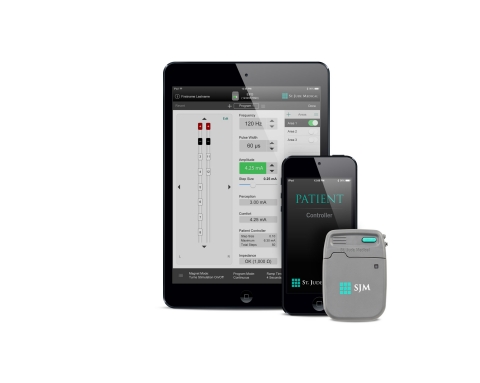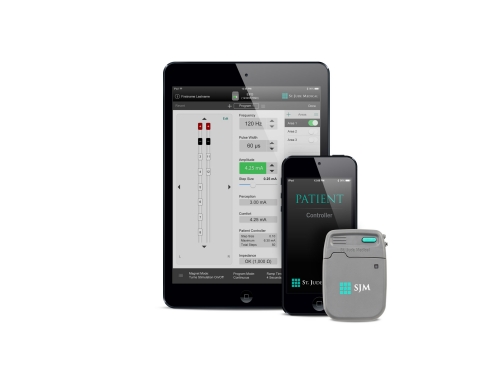ST. PAUL, Minn.--(BUSINESS WIRE)--St. Jude Medical, Inc. (NYSE:STJ), a global medical device company, today announced FDA approval of the St. Jude Medical™ Invisible Trial System. The system, which received CE Mark in June 2015, is fully wireless and leverages Apple™ technology for both the patient and physician controllers. The system is designed to provide patients a more improved and discreet spinal cord stimulation (SCS) trial experience.
For many patients, SCS therapy can be an effective option for managing chronic pain. The therapy relies on a small implanted device and thin wires (known as leads) to deliver low levels of electrical energy to mask or interrupt pain signals as they travel along nerve fibers to the brain, which reduces the sensation of pain. Prior to receiving a permanently implanted SCS device, patients undergo a minimally invasive “trial” period to evaluate the therapy. Yet for some patients, complex controllers and bulky programming cables can disrupt the trial experience and act as barrier to SCS therapy.
With the Invisible Trial System, St. Jude Medical has removed these barriers, allowing patients to more effectively evaluate their SCS therapy. The system relies on Bluetooth® wireless technology to provide patients a safe, secure and entirely wireless SCS trial experience. Rather than a complex controller, the St. Jude Medical Invisible Trial System provides patients with a more intuitive iPod touch™ digital device as a controller, while physicians will utilize an iPad mini™ digital device to program and evaluate their patient’s therapy.
“Patients undergoing SCS trials consistently tell us about challenges they find in navigating the SCS trial system, from programming the device, to discomfort from the programming cables, to management of both issues. These hindrances may impede the integration of the technology into their daily activities, which shifts their focus away from evaluating the effectiveness of SCS therapy,” said pain specialist Dr. Jason E. Pope, president of Summit Pain Alliance in Santa Rosa, Calif. “By providing a discreet trial system, St. Jude Medical will help patients focus more on their potential pain relief and functional improvements, and less about the burdens common to traditional trial systems.”
One of the key system features of the St. Jude Medical Invisible Trial System is the use of a small external pulse generator (EPG) as the system’s power source. Because the EPG uses Bluetooth wireless technology to communicate between the patient’s iPod touch controller and the stimulation system, the overall device profile has been reduced so the system can be worn discreetly under a patient’s clothing. The effect is that the system feels essentially “invisible” to the wearer, providing a more comfortable trial experience that allows patients to focus entirely on their system’s therapeutic impact during their trial.
“When we developed the new Invisible Trial System, we took into account physician and patient feedback that current trial systems were in some cases preventing patients from adequately assessing their therapy,” said Eric S. Fain, M.D., group president of St. Jude Medical. “By providing a more patient-friendly option, we think we can shorten the learning curve related to trial programming devices and allow patients to better assess the potential pain relief they’re receiving from spinal cord stimulation.”
The iPod touch controller offers patients a simple, familiar platform to adjust their therapy. An iPad mini tablet is used by the patient’s physician to set the programming parameters. The programmer also displays trial usage data from the EPG and allows the physician to print or email the data in PDF format. Bluetooth wireless technology safely and securely communicates wirelessly between the EPG and patient and physician devices, eliminating the programming trial cable and thus increasing the patient’s comfort.
Note: Apple, iPod touch and iPad Mini are trademarks of Apple, Inc. Bluetooth is a trademark of Bluetooth SIG, Inc.
About the St. Jude Medical Chronic Pain Portfolio
Chronic pain affects approximately 1.5 billion people worldwide, more than heart disease, cancer and diabetes combined. The condition can negatively impact mood, personal relationships, work productivity, and activities of daily living. St. Jude Medical offers multiple solutions for patients to manage debilitating chronic pain, including spinal cord stimulation (SCS) and radiofrequency ablation (RFA).
About St. Jude Medical
St. Jude Medical is a global medical device manufacturer dedicated to transforming the treatment of some of the world’s most expensive epidemic diseases. The company does this by developing cost-effective medical technologies that save and improve lives of patients around the world. Headquartered in St. Paul, Minn., St. Jude Medical has four major clinical focus areas that include cardiac rhythm management, atrial fibrillation, cardiovascular and neuromodulation. For more information, please visit sjm.com or follow us on Twitter @SJM_Media.
Forward-Looking Statements
This news release contains forward-looking statements within the meaning of the Private Securities Litigation Reform Act of 1995 that involve risks and uncertainties. Such forward-looking statements include the expectations, plans and prospects for the Company, including potential clinical successes, anticipated regulatory approvals and future product launches, and projected revenues, margins, earnings and market shares. The statements made by the Company are based upon management’s current expectations and are subject to certain risks and uncertainties that could cause actual results to differ materially from those described in the forward-looking statements. These risks and uncertainties include market conditions and other factors beyond the Company’s control and the risk factors and other cautionary statements described in the Company’s filings with the SEC, including those described in the Risk Factors and Cautionary Statements sections of the Company’s Annual Report on Form 10-K for the fiscal year ended January 3, 2015 and Quarterly Report on Form 10-Q for the fiscal quarter ended April 4, 2015. The Company does not intend to update these statements and undertakes no duty to any person to provide any such update under any circumstance.




